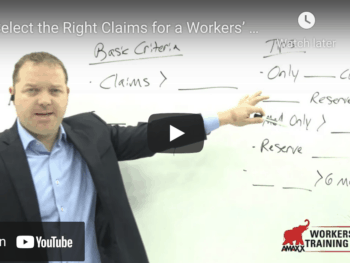
This claim gathering of incurred values is known as the Unit Statistical Reporting program. These incurred loss values must be reported six months prior to the policy renewal date. States require data for policies over the past three years. This means that a policy with a 2014 renewal date must also have data from 2013 an 2012.
Beginning Data:
If a policy has an expiration date of August 1, 2014 the unit stat reports must be filed February 1, 2014. Since states require a three year record of incurred claim values, it means incurred values on policies that expired 8/1/2013 and 8/1/2012 must also be included with the 8/1/14 policy reporting.
Changes of values since last reporting for prior policy years will again play apart in the experience modification calculation.
It is recommended that the claim review process begin at least two months prior to the mandated filing date. In the example cited, that means a review date of 12/1/13 would be appropriate for a policy renewing 8/1/14.
Obtain a claim loss run as of 12/1/13 for all three policy years that will be used in the unit stat reporting.
Click Link to Access Free PDF Download
“Workers’ Comp Claims Review Checklist: 9 Must-Have, Serious-Impact Elements”
Reviewing the Loss Runs:
The loss runs need to be studied for dates of loss, reserves, payments, expenses, description of losses, nature of injury, and proper classification for the loss.
Medical only claims need to be reviewed for payments, length of activity and treatment to determine if they are truly medical claims.
Generally, the average indemnity claim has an open status of 1 year to 18 months. A medical only claim should be resolved in 8 to 10 months.
The reasons for listing the items to study are too numerous and lengthy for this memo alone. One example for an item to study is the Date of Loss. First, it must fall within the proper policy year. It must be determined when the loss was reported. Did the date fall during the normal work week? If it occurred on a holiday or weekend, was that employee properly scheduled to work?
Because the reasons are so complex, Claim reviews should always be conducted by experienced claim professionals or persons thoroughly knowledgeable in claim programs and best practice claim handling. The claim professional will have the experience and knowledge to choose claims for full review.
If it is a herculean task to choose claims due to sheer numbers, a statistical sample of 10 to 15 percent may be enough. If large issues develop from the sample reports, each adjuster should be asked to review all claims on their assignment that are causing the issues. The supervisor should review the adjuster’s reports and certify as to their propriety and accuracy.
Reviewing the Loss:
Once the claim is chosen to review, a claim report should be obtained from the adjuster handling the loss. It must contain sufficient information to demonstrate proper investigation, handling and plans for disposition. Comment is necessary for re-insurance potential. Retention levels and reporting requirements need to be covered. Special handling needs and authorities need to be incorporated when applicable.
Financial information needs to be included. This will determine proper reserving with documentation for the change. The reviewer will look for stair-step reserving and proper reserve diary.
The payment coding needs to be proper, and a copy of the codes is necessary for this. Over payments, duplicate payments will all have to be taken out for the final report. (Some larger insurance carriers and TPA’s automatically provide claim review reports based on contractual agreements with the employers. These may be forwarded with the loss runs. In some instances a claim reviewer does a physical file review in person. Some reviews are conducted by electronic access. A few organizations still provide paper responses.)
Negotiating Corrections:
Everyone hates to be second guessed. There is a natural tendency for those not handling the actual claim to have expectations that may not be possible.
Adjusters will naturally be defensive and resistive to suggestion. They may have attitude issues concerning the law and their limited power.
The claim reviewer needs to be aware of these tendencies, and preparation is the key to successful negotiation. While it is a good idea for the reviewer to be aware of the jurisdictional idiosyncrasies in the law, it is unwise to be too well versed as poor handling may be excused. It is far better to have the adjuster use the law as an explanation as to why things may not have been done according to Claim Handling Best Practices. The reviewer should review according to Best Practices at all times.
The reviewer should take “I am here to help you do your job better” attitude at all times. Use a friendly tone of voice when speaking to the adjuster. Be very careful to use words that are non-inflammatory or that could be misinterpreted in both verbal and written contact. Always praise good work first.
When making suggestions or criticisms use comments like: “I am sure you thought of this. Can you tell me why it did not work? What do you think about trying this? I note that the claim record did not include comments on (whatever the subject) you may have had good reason can you tell what it was? What obstacles are you encountering that are adversely impacting your job performance? Have you thought of? Will you be doing? What tools do you employ to overcome resistances to your handling needs?
If an adjuster hesitates to supply medical information due to confidentiality or privacy law, point out that it is well established that the employer has the right to know that the employee can physically do the job. All information provided will only be shared with properly authorized individuals.
Most adjusters are used to claim reviews and will respond positively. Occasionally there may be one who is completely unresponsive or cooperative. At that point managerial intervention may be required. Such attitude also implies bad claim handling and claimant confrontation. Serious consideration needs to be given to discipline or termination procedures
Approving and Testing Data for Unit Stat Reporting:
Once the review is completed and all negotiated changes are agreed to request the corrected loss runs. The reviewer should recheck the accuracy of the new runs and certify them as correct for use in the stat reports.
The broker, agent, underwriter, actuary, certified rater, or risk manager should then do a test calculation of the experience modification before sending in the unit stat reports. If the state’s calculation differs too much these are the same people who would have power to discuss differences with the state.
Summary:
Claim reviews are vital and necessary to be sure data supplied to the states on the unit statistical reports are correct. They should be timely and done far enough in advance of reporting to allow for proper adjustments. A test modification should be done prior to filing the unit stat reports.

©2014 Amaxx Risk Solutions, Inc. All rights reserved under International Copyright Law.
SALES TO PAY FOR ACCIDENTS CALCULATOR: http://reduceyourworkerscomp.com/sales-to-pay-for-accidents-calculator/
WC GROUP: http://www.linkedin.com/groups?homeNewMember=&gid=1922050/
Do not use this information without independent verification. All state laws vary. You should consult with your insurance broker, attorney, or qualified professional.















